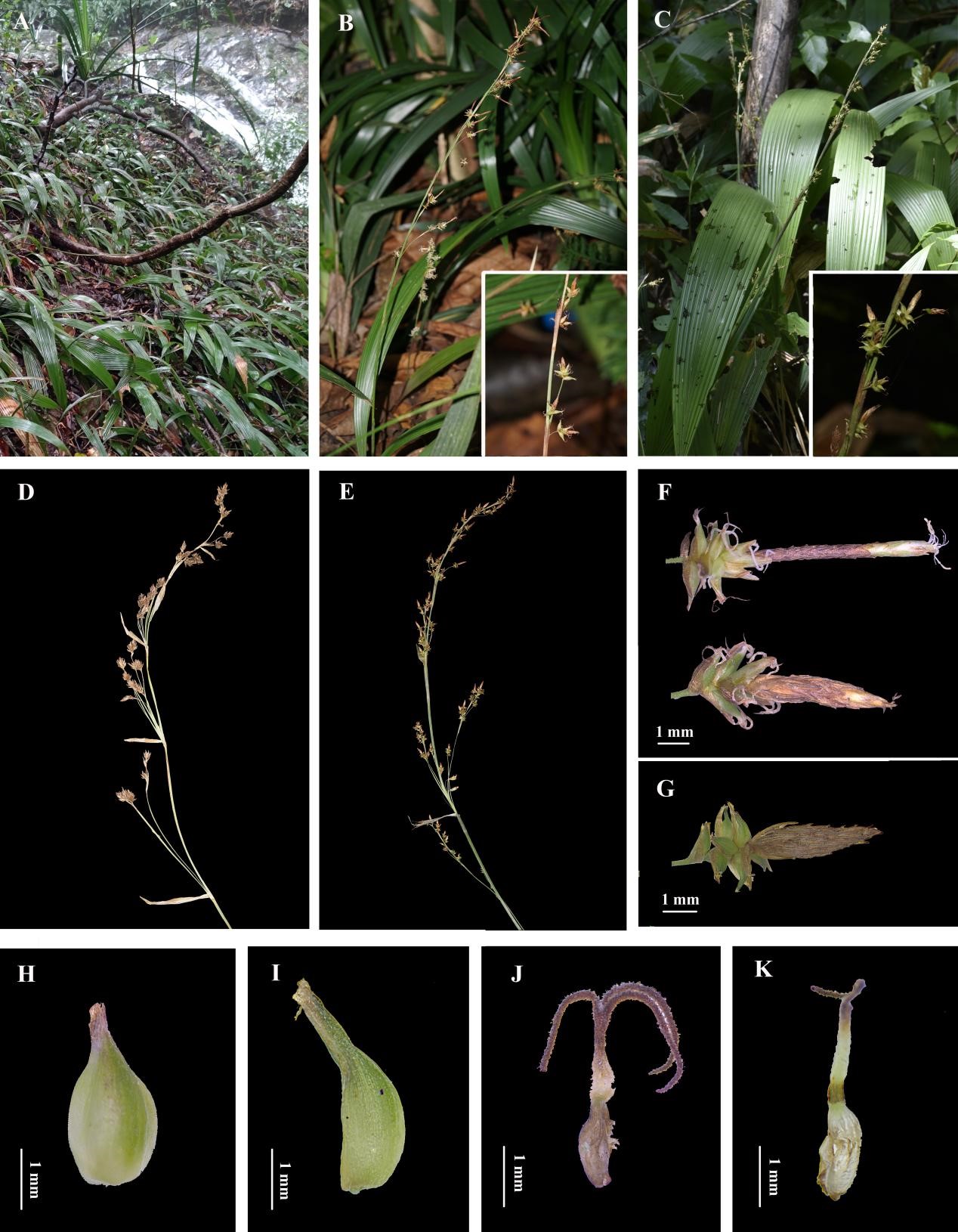Carex qingyuanensis, a new species from Qingyuan, Guangdong
Carex Linnaeus with ca. 2000 species, is one of the largest angiosperm genera and is distributed almost globally. The rapid advancement of sequencing technology has significantly enhanced our comprehension of the relationships within Carex. According to the latest study, Carex lineages encompassing six subgenera, 62 formally designated Linnean sections, and 49 informal groups. Since 2010, there are about 40 new species described in China.
In February 2022, the Biodiversity Conservation and Utilization Research Group (PI: Professor Hongfeng Chen) of South China Botanical Garden, Chinese Academy of Sciences, discovered a new species during a botanical survey in Bijia Mountain Forest Farm. The discovery was made in collaboration with Senior Engineer Qiu-gen Zeng from Qingyuan Forestry Bureau and Forest Ranger Ming-kai Zhang from Bijia Mountain Forest Farm. The sample was collected and brought back to the South China Botanical Garden for further study. By combining with the morphological study from the flora of China, the guidance from Professor Yunfei Deng, and detailed morphological observation under a stereomicroscope, it was confirmed that the species belongs to Carex sect. Siderostictae s.s. The new species is morphologically similar to Carex peliosanthifolia F. T. Wang & Tang ex P. C. Li. Furthermore, they visited IBSC in order to study the specimen of C. peliosanthifolia for a more precise morphological comparison between the two species, particularly focusing on the characteristics of inflorescence and perigynium. Finally, they found the new species show differences in the racemose inflorescence branches, number of spikes, length of the male part of spikes, style base thickened or not, and the shape of beak (Fig. 1).
Moreover, in order to conduct a thorough morphological comparison and phylogenetic analysis, samples of similar species C. peliosanthifolia and Carex scaposa C. B. Clarke were collected from Shangguchen, Jinxiu County, Guangxi Province, China in July 2023. A total of 21 samples representing two sections and three clades respectly were used for molecular phylogenetic analysis, based on the updated the infrageneric classification of Carex and the sequencing available on GenBank. Two nuclear DNA regions (ETS 1f and ITS) and three chloroplast DNA regions (matK, ndhF and rps16) were used for the phylogenetic analysis. According to the topology (Fig. 2), among the 13 species within sect. Siderostictae s.s., the new species shows a closer phylogenetic relationship to C. scaposa rather than to C. peliosanthifolia. To sum up, both morphological and phylogenetic study indicate the species is a new one in Carex sect. Siderostictae s.s. Based on the type specimen’s location, the new species was named as Carex qingyuanensis Y.L. Li & H.F. Chen.
Carex sect. Siderostictae s.s. includes 27 species, in three traditional sections: Hemiscaposae (12 species), Siderostictae s.l. (13 species) and Surculosae (2 species). Traditionally, C. qingyuanensis belongs to sect. Hemiscaposae. The sect. Hemiscaposae is unique in Carex for its androgynous inflorescence units, leafless pseudolateral culms and pseudopetiolate leaves. The leaves of which are much wider (up to 12 cm). Moreover, the section is noted especially for its unprecedented variety of inflorescences, ranging from simple to compound. Eight species have been described within sect. Hemiscaposae, primarily found in broadleaf evergreen forests in southern-central and southeast China (including Taiwan). Despite the relatively small number of species, their classification is challenging due to subtle characteristic differences. The description of C. qingyuanensis enriches the records of Carex sect. Siderostictae in Guangdong Province. Besides, the related artical is published in PhytoKeys. The PhD student Ya-li Li is the first author of the paper, and Professor Hong-feng Chen is the corresponding author. This study received financial support from the Key Research and Development Program of Guangdong Province (2020B1111530004) and the Guangzhou Science and Technology Project.
The article link is: https://phytokeys.pensoft.net/article/117734/
First author information: Ya-li Li: PhD student. Plant Sciences Center, South China Botanical Garden, Chinese Academy of Sciences. Research field: Conservation Biology. E-mail: liyali@scbg.ac.cn ; Tel :15011794942.


File Download: